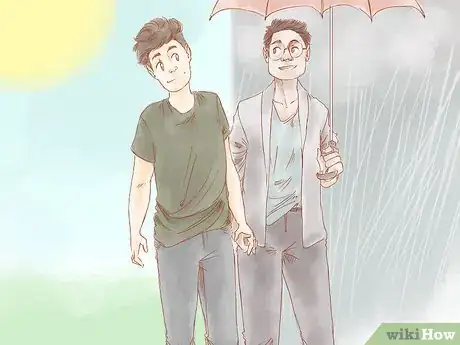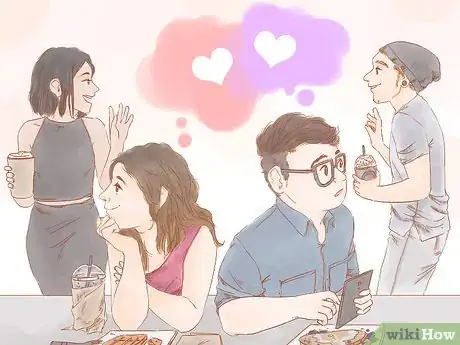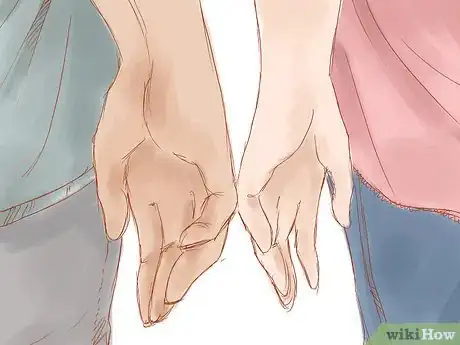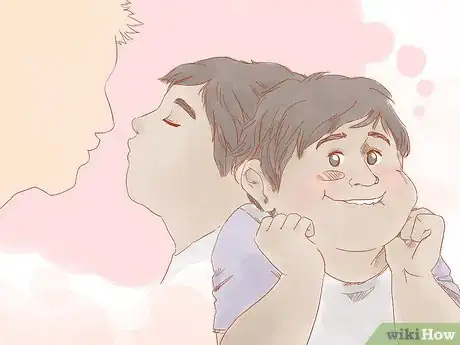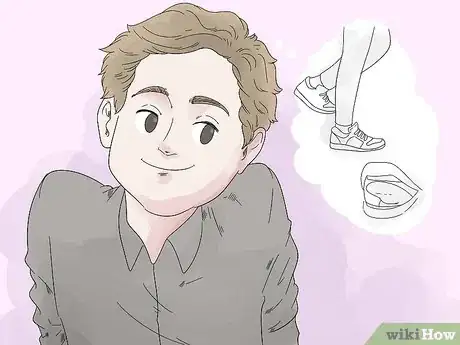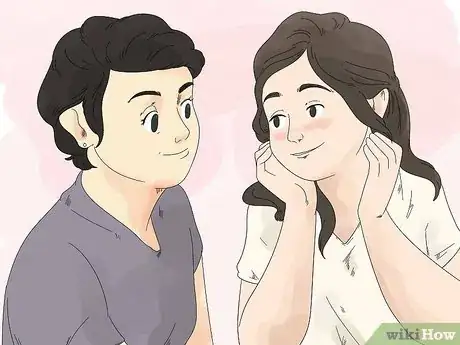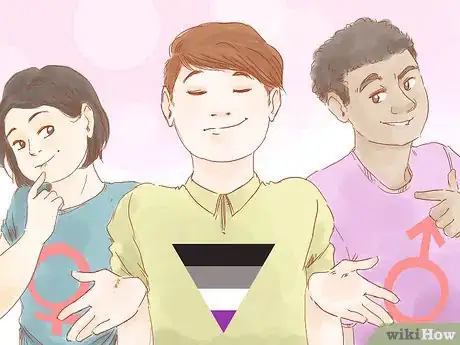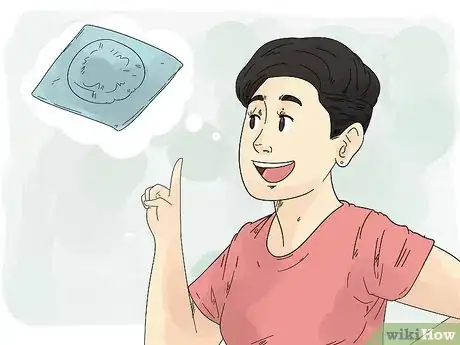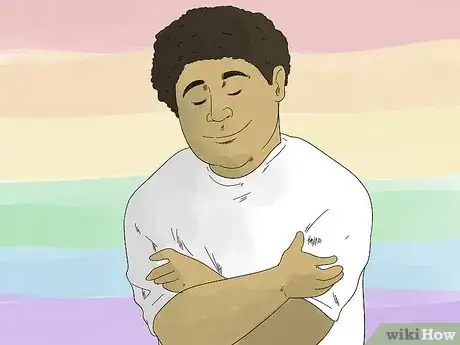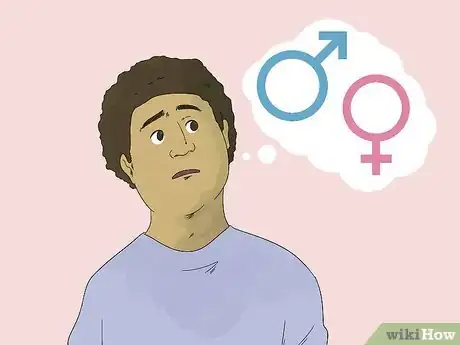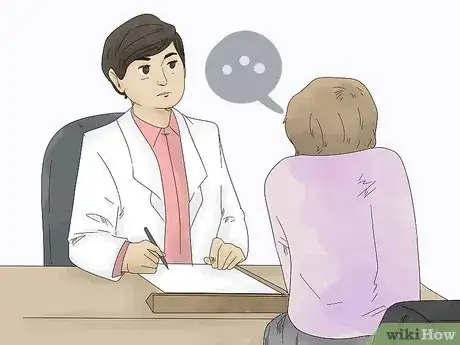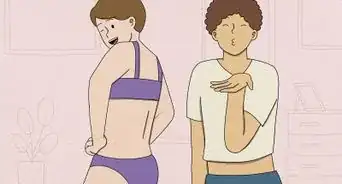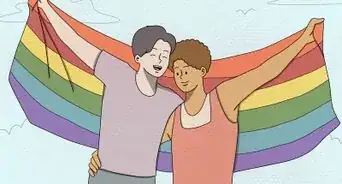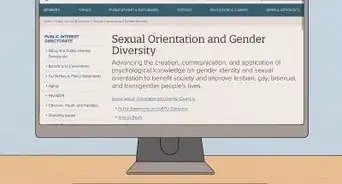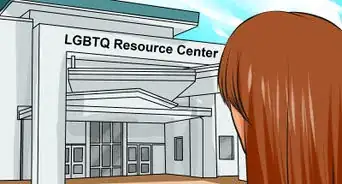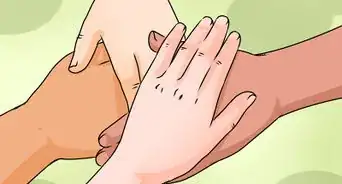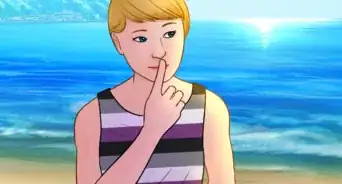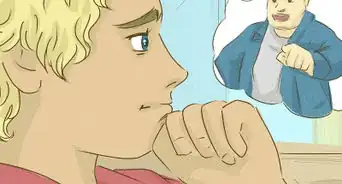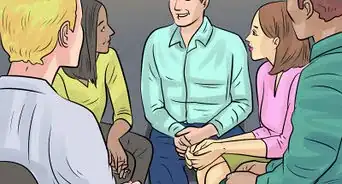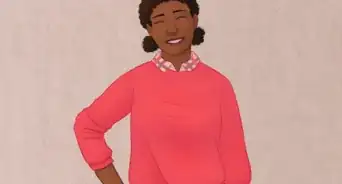This article was co-authored by Marissa Floro, PhD and by wikiHow staff writer, Danielle Blinka, MA, MPA. Dr. Marissa Floro, Ph.D. is a Psychologist and Instructor at Stanford University’s Weiland Health Initiative and adjunct faculty at the University of San Francisco. Dr. Floro received her Ph.D. in Counseling Psychology from Loyola University Chicago, focusing on the intersections of race, attraction, and gender. Dr. Floro’s continued clinical, teaching, and advocacy work focuses on sexual and gender diversity, racial identity and belonging, and liberation from oppressive systems and structures.
There are 17 references cited in this article, which can be found at the bottom of the page.
This article has been viewed 4,896,496 times.
Maybe a strange feeling bubbles in your chest when one of your peers is around, or you don’t feel like your sense of attraction lines up with the rest of society’s. Could this be a sign that you’re attracted to people who are the same gender as you?[1] Ultimately, only you can decide where your identity falls—and we’re here to help you along your journey. In this article, we’ll unpack everything you need to know about sexuality, attraction, and everything in between, so you can feel comfortable and secure with your identity.
Steps
Examining Your Thoughts and Behaviors
-
1Explore the different ways that you’re attracted to other people. Attraction isn’t just one thing—it’s an umbrella term for how you wish to connect with someone (whether that’s romantic, sexual, platonic, or something completely different).[2] When you’re out and about (or surfing the web), pay attention to who catches your eye. Are you attracted to people of the same gender, opposite gender, or a mix of both? Gay individuals are romantically or sexually attracted to people who are the same gender as them.[3]
- Curious about the different types of attraction out there? Here’s a quick breakdown:
- Romantic attraction: Wanting to be romantic with someone
- Sexual attraction: Wanting to be sexual with someone
- Platonic attraction: Wanting to be friends with someone
- Sensual attraction: Wanting to cuddle and hug someone
- Aesthetic attraction: Liking how someone physically looks[4]
- Do you feel obligated to have a crush on people of the opposite gender (or feel a societal pressure to identify that way)? If so, you might be experiencing compulsory heterosexuality, or a sense of societal obligation to be attracted to someone of the opposite gender.[5]
- Curious about the different types of attraction out there? Here’s a quick breakdown:
-
2Pay attention to who sexually arouses you. Look at pictures of people who are commonly viewed as “attractive” and see which gender(s) arouse you. If you’re more aroused by people who are the same gender as you, you might be gay. If you find more than one/or the same gender as you arousing, you might fall under a different LGBTQ+ label.[6]
- Keep in mind that experiences of sexual arousal are extremely nuanced, and aren’t concrete proof that you’re gay. For instance, you can be aroused by gay adult media without necessarily being gay yourself.[7]
Advertisement -
3Take a closer look at who you’ve crushed on in the past. A crush is typically a strong experience of romantic attraction for another person—when you have a crush on someone, you typically want to date them and take your relationship to a new, romantic level.[8] If you tend to develop crushes on people who are the same gender as you, it could be a sign that you’re gay.[9]
- Not all crushes are one and the same—some might be rooted in romantic attraction (the desire to date someone), while some might be rooted in sexual attraction (the desire to be sexual with someone). Some people might develop romantic crushes but never actually be sexually attracted to that person—and that’s totally valid![10]
- Keep in mind that it’s normal to feel attracted to someone who’s the same gender as you, especially when you’re still figuring your sexual orientation.[11] [12]
-
4Reflect on your past relationships and how they made you feel. You can be gay even if you’ve had straight relationships in the past. Think about who you dated in the past and how comfortable you felt in the relationship. Ask yourself if you felt attracted to this person and what type of attraction you felt. This can help you figure out if you might be queer.[13]
- For example, let’s say you’re a guy who’s had, several girlfriends. If you felt uncomfortable with physical contact with each girl, you may be gay.
- Keep in mind that you might just not be ready for intimacy or maybe asexual, both of which are okay. You don’t have to do anything that makes you uncomfortable.
-
5Examine your sexual fantasies to help identify your sexual orientation. Reflect on the type of fantasies you’ve had in the past. Notice what you were doing and who you tend to think about. If you often fantasize about relationships involving specific genders, you may be queer or gay.[14]
- As an example, let’s say you tend to think about people who are the same sex as you are whenever you masturbate. You may be gay, but you could also be pansexual or bisexual if you sometimes think about the other gender.
- Think about who you identify with most during romantic or sex scenes in movies or TV. For instance, if you’re a girl who identifies with the guy character because you want to kiss the girl, you may be interested in girls.
-
6Don’t assume you’re gay based on how you walk, talk, or dress. You’ve probably heard stereotypes about what makes someone gay, but none of these are true. Your sexual orientation has nothing to do with your style, appearance, or how you speak. Similarly, walking or dancing a certain way doesn’t make you gay, either. Ignore these stereotypes when figuring out your sexual orientation.[15]
- For instance, having a high-pitched voice as a guy doesn’t make you gay. Similarly, preferring short hair as a girl doesn’t make you a lesbian.
Experimenting with Your Attraction
-
1Flirt with someone you like to see if it feels right. Start by giving a compliment to someone you think is attractive. If they seem comfortable with it, playfully touch their arm or shoulder. See how it makes you feel.[16]
- You might say, “That color looks amazing on you.”
- If you enjoy flirting with the same gender, you might be gay or queer.
- If you feel like it’s boring or awkward, you may be straight.
-
2Kiss or hold hands with someone who’s the same gender/another gender if you want. Physical intimacy like kissing or holding hands will help you figure out if you might enjoy being with someone who’s the same gender as you, or another gender identity such as non-binary. Take things slow and start by holding hands with them. Then, consider kissing them if you both seem to be comfortable with it.[17]
- Pay attention to how you feel during these experiences. Waves of warmth, excitement, anticipation, a racing heart, and/or a breathless feeling are all signs that you feel free really good and are enjoying the experience.[18]
- Keep in mind that feelings of pleasure and fear sometimes give off similar signals. Take some time to explore if your feelings are rooted in pleasure, anxiety, or fear.[19]
-
3Use protection if you decide to go all the way with someone. If you want to be sexually intimate with someone, use a condom or dental dam to protect both of you from sexually transmitted infections (STIs). You are still at risk, for STIs or STDs regardless of your relationship type. [20]
- Only have sex with someone if it’s really what you want. Don’t be afraid to take things slow.
- Keep in mind that even if you have a sexual experience with someone of the same gender or another gender, that doesn’t necessarily mean that you’re gay. Likewise, having sex with someone of the ‘opposite’ gender doesn’t have to mean that you’re straight.
-
4View your sexual identity as something that’s fluid. Things would be so simple if you could just label yourself as gay and be done with it, but it may not be that easy. It’s normal for you to have questions and change your mind sometimes. Listen to how you feel and respect your personal preferences at the moment.[21]
- Remember: the only person’s opinion that matters regarding your sexuality is yours. Don’t feel pressured to choose a specific label because of what other people are saying. The only person you need to listen to is you![22]
Identifying as Gay
-
1Celebrate your sexual identity as part of who you are. Embracing who you are is something to celebrate, so be proud of yourself. Recognize that you are perfect the way you are and permit yourself to be you.[23]
- If you’re not ready to tell everyone that you’re gay, that’s okay! This doesn’t mean you aren’t proud. It’s normal to be nervous, so take your time and come out when you feel it’s the right time.[24]
-
2Label your sexual identity when - if ever - you feel ready. Take your time to figure out your sexual orientation. It’s okay if it takes you a while and if you change your mind. It’s normal to experiment and question your sexual orientation. When you feel ready, decide on which label you want to use for yourself.[25]
- For instance, you might think you’re pansexual because you’ve dated nonbinary folks, men, and women. However, you might later realize you’re gay. It’s okay to change your mind and re-label yourself.
-
3Come out on your terms. There’s no right or wrong way to come out. Your sexual identity is personal, so you don’t owe anyone an explanation. At the same time, being out and proud may help you feel like you’re being true to yourself. When you’re ready, tell someone you trust about your sexual orientation, like a family member, friend, or teacher. Then, slowly tell the other people who are important to you.[26] [27]
- For instance, you might start with your best friend. Tell them, “Have you noticed that I talk a lot about guys? I think I’ve begun to realize that I’m attracted to men and I might be gay.”
- When you tell your parents, it might help to bring educational resources for parents who have queer children. Say, “I love you, so I want to share something important with you. I’m gay, and I’m proud of it. Since I realized this, I’m feeling really happy and excited about falling in love. I hope you can understand and support me.”
- Don’t feel like you have to take things slow if you’re ready to come out. If you want people to know your sexual identity, go ahead and tell them.
- If you're questioning your sexual identity, seek out people you know will be supportive. That might be a friend, a teacher, a leader in your community, or mental health professional. If you live in an area where you don't feel you'd have a lot of support, look for online resources, support groups, and forums that could help you.
- Coming out is a lifelong journey, not something you do just once.[28]
- Coming out is an individual process. Choosing to ignore the ways that people are pressuring you to come out doesn’t negate your identity in any way. For some people, coming out isn’t an option, nor is it a goal, but that doesn't make those individuals any less part of the community![29]
-
4Try out different LGBTQ+ labels and see if they’re a good fit for you. While “gay” is a totally valid label to identify with, it isn’t the only LGBTQ+ label out there. You might find that terms like queer, bisexual, or pansexual might be a better fit for you and your sense of attraction. Here’s a quick breakdown of what these labels mean:
- Bisexual: Someone who’s typically attracted to people from more than one gender. This label is very nuanced, and there are different definitions for bisexuality out there—click here if you’d like to learn more.[30] Some people say that bisexual people are "confused" or "going through a phase," but this couldn't be further from the truth.[31]
- Pansexual: Someone who is attracted to people first and gender second.[32]
- Queer: Someone who doesn’t identify as heterosexual, but doesn’t feel like other LGBTQ+ labels are a good fit for them.[33]
-
5Reach out to a counselor if you’re struggling emotionally. It’s normal to have conflicted emotions when you’re exploring your sexual identity. But if you’re overwhelmed by feelings of guilt, sadness, or anxiety, or if you aren’t getting the support you need from your family members or community, some people can help.[34] Ask your doctor to recommend a counselor. Or, if you’re a student, find out if your school offers counseling services.
- You can also find support groups online or call a crisis line that’s dedicated to LGBTQ issues. For example, young people living in the U.S. can call the Trevor Project 24/7 at 1-866-488-7386.[35]
- Sometimes, it can be really helpful to connect with other people who are going through similar experiences. You can find some of these people online (like in certain subreddits), or in peer support groups through different LGBTQ+ counseling centers.[36]
Warnings
- Practice safe sex at all times. Keep in mind that same-sex sexual activities can lead to sexually transmitted infections (STIs) just like any sexual encounter can.⧼thumbs_response⧽
References
- ↑ https://www.hrc.org/resources/glossary-of-terms
- ↑ https://acrobat.adobe.com/link/track?uri=urn%3Aaaid%3Ascds%3AUS%3Ae3df2ccc-ce8f-3e31-81c6-0b7ad3effb3b#pageNum=1
- ↑ https://www.hrc.org/resources/glossary-of-terms
- ↑ https://acrobat.adobe.com/link/track?uri=urn%3Aaaid%3Ascds%3AUS%3Ae3df2ccc-ce8f-3e31-81c6-0b7ad3effb3b#pageNum=1
- ↑ Marissa Floro, PhD. Counseling Psychologist. Expert Interview. 9 January 2023.
- ↑ https://www.healthyplace.com/gender/gay/how-do-i-know-if-i-am-gay-signs-you-are-gay
- ↑ Marissa Floro, PhD. Counseling Psychologist. Expert Interview. 9 January 2023.
- ↑ https://www.aromanticism.org/en/attraction-relationship-terms
- ↑ https://kidshealth.org/en/parents/sexual-orientation.html
- ↑ Marissa Floro, PhD. Counseling Psychologist. Expert Interview. 9 January 2023.
- ↑ https://kidshealth.org/CookChildrens/en/teens/sexual-orientation.html
- ↑ Marissa Floro, PhD. Counseling Psychologist. Expert Interview. 9 January 2023.
- ↑ https://www.nhs.uk/live-well/sexual-health/am-i-gay-lesbian-or-bisexual/
- ↑ https://www.healthyplace.com/gender/gay/how-do-i-know-if-i-am-gay-signs-you-are-gay
- ↑ https://kidshealth.org/en/parents/sexual-orientation.html
- ↑ https://www.nhs.uk/live-well/sexual-health/am-i-gay-lesbian-or-bisexual/
- ↑ https://kidshealth.org/en/parents/sexual-orientation.html
- ↑ Marissa Floro, PhD. Counseling Psychologist. Expert Interview. 9 January 2023.
- ↑ Marissa Floro, PhD. Counseling Psychologist. Expert Interview. 9 January 2023.
- ↑ https://www.teensource.org/hookup/exploring-your-sexuality-takes-time-and-courage
- ↑ https://kidshealth.org/en/parents/sexual-orientation.html
- ↑ Marissa Floro, PhD. Counseling Psychologist. Expert Interview. 9 January 2023.
- ↑ https://kidshealth.org/en/parents/sexual-orientation.html
- ↑ Marissa Floro, PhD. Counseling Psychologist. Expert Interview. 18 February 2021.
- ↑ https://www.nhs.uk/live-well/sexual-health/am-i-gay-lesbian-or-bisexual/
- ↑ https://www.psychologytoday.com/us/blog/gay-and-lesbian-well-being/201103/should-you-come-out-your-parents?destination=node/56990
- ↑ Marissa Floro, PhD. Counseling Psychologist. Expert Interview. 18 February 2021.
- ↑ Marissa Floro, PhD. Counseling Psychologist. Expert Interview. 18 February 2021.
- ↑ Marissa Floro, PhD. Counseling Psychologist. Expert Interview. 9 January 2023.
- ↑ Marissa Floro, PhD. Counseling Psychologist. Expert Interview. 9 January 2023.
- ↑ Marissa Floro, PhD. Counseling Psychologist. Expert Interview. 18 February 2021.
- ↑ Marissa Floro, PhD. Counseling Psychologist. Expert Interview. 9 January 2023.
- ↑ https://www.glaad.org/reference/terms
- ↑ https://www.cdc.gov/lgbthealth/youth-resources.htm
- ↑ https://www.thetrevorproject.org/
- ↑ Marissa Floro, PhD. Counseling Psychologist. Expert Interview. 9 January 2023.
- ↑ https://www.glaad.org/how-sexual-orientation-different-gender-identity
- ↑ https://www.nhs.uk/live-well/sexual-health/am-i-gay-lesbian-or-bisexual/
- ↑ https://www.apa.org/topics/lgbt/orientation
- ↑ https://www.ncbi.nlm.nih.gov/pmc/articles/PMC1114912/
About This Article
If you’re not sure how to know if you are gay, think about any past romantic experiences you have had. If you have had only had crushes on people of a different gender, you are probably straight. If you have had romantic experiences or fantasies involving people who are the same gender as you, then there is a good chance you are gay or bisexual, but it's okay if you're a little confused. Also, if you don't want to, you don't have to label yourself at all. You like who you like, and you can leave it at that. It may help to think of loving people, rather than their gender. To learn more about how to be comfortable with your sexuality, keep reading!


